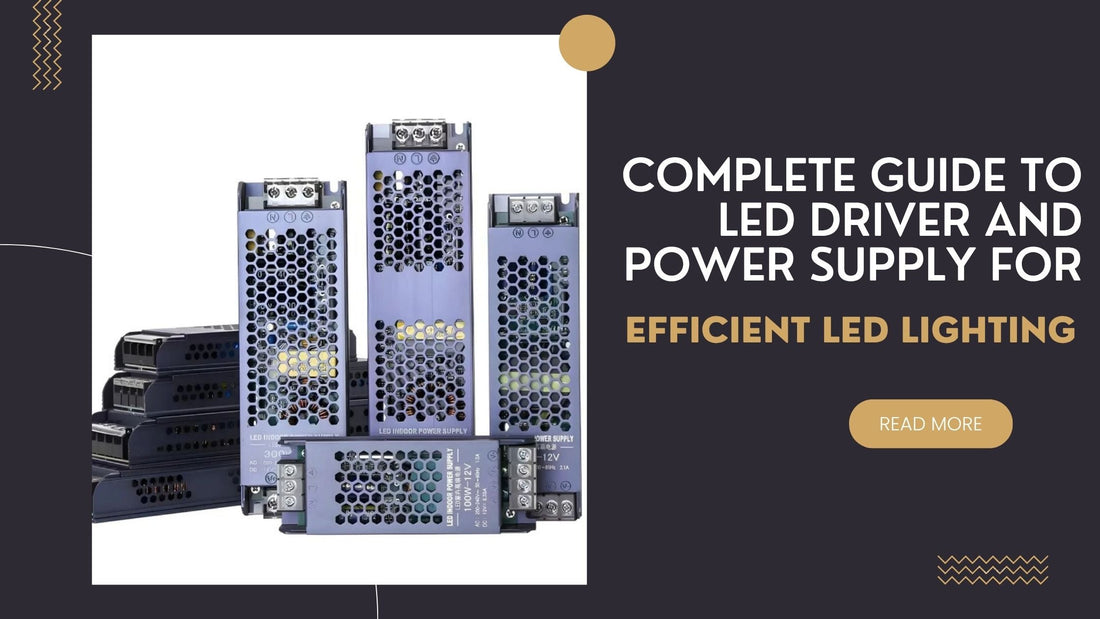
Complete Guide to LED Driver and Power Supply for Efficient LED Lighting
Share
Introduction
Lighting technology has evolved significantly, with LEDs becoming the cornerstone of modern illumination systems. However, powering these LEDs efficiently requires specialized components like LED driver and power supply. While both serve the purpose of delivering power, their functionalities and applications differ vastly. This comprehensive guide will delve into the intricacies of these devices, helping you understand their roles, differences, and how to select the right one for your specific needs. Whether you're a homeowner, a commercial builder, or an industrial engineer, this knowledge is indispensable for optimizing your lighting systems.
What Is an LED Driver?
An LED driver is an electronic device designed to regulate the power supplied to LEDs or LED arrays. Unlike conventional power supplies, LED drivers are engineered to provide a constant current or voltage, ensuring that LEDs operate within their optimal parameters. This precision is crucial because LEDs are sensitive to fluctuations in power, which can lead to inconsistent brightness, overheating, or even premature failure. Here’s a deeper look at why LED drivers are indispensable:
- Prevents Overheating and Burnout: By maintaining a steady current, LED drivers mitigate the risk of thermal runaway, a common issue where excessive current causes LEDs to overheat and fail.
- Ensures Brightness Uniformity: Consistent power delivery guarantees that all LEDs in a system emit light uniformly, avoiding patches of uneven illumination.
- Extends Lifespan: LEDs powered by dedicated drivers often outlast those connected to generic power supplies, as the latter may subject the LEDs to harmful power spikes or drops.

Among the various types, a constant current dimming LED driver is especially useful when precise brightness control and energy efficiency are required in lighting applications.
What Is a Power Supply?
A power supply is a versatile device that converts electrical energy from a source (like an outlet or battery) into a form suitable for powering electronic devices. While power supplies can technically power LEDs, they lack the specialized features of LED drivers. Here’s what sets them apart:
- Fixed Output: Power supplies typically deliver a fixed voltage or current, which may not align with the dynamic needs of LEDs.
- Broad Compatibility: These devices are used across a wide range of electronics, from household appliances to medical equipment, making them less tailored for LED-specific requirements.
- Additional Components: To work effectively with LEDs, power supplies may need supplementary circuitry, such as resistors or regulators, to prevent damage.
Key Differences Between LED Driver and Power Supply
To make an informed choice, it’s essential to understand the fundamental differences between these two components. Below is an expanded comparison:
| Feature | LED Driver | Power Supply |
|---|---|---|
| Purpose | Exclusively designed for LEDs, ensuring optimal performance and longevity. | General-purpose device used for a variety of electronic applications. |
| Current Regulation | Provides constant current or voltage, tailored to LED specifications. | Offers fixed voltage or current, which may not adapt to LED needs. |
| Compatibility | Optimized for LEDs, with built-in protections against power fluctuations. | Compatible with multiple devices but may require modifications for LEDs. |
| Lifespan | Enhances LED lifespan by preventing overcurrent and thermal stress. | May not prioritize LED longevity, potentially leading to faster degradation. |
Applications of LED Drivers and Power Supplies
The suitability of LED driver and power supply depends largely on the application. Here’s a detailed breakdown of where each excels:
Applications of LED Drivers
- Residential and Commercial Lighting: LED drivers are the backbone of modern lighting systems in homes, offices, and retail spaces, ensuring energy efficiency and reliability.
- Automotive Lighting: From headlights to interior lighting, LED drivers provide the precision needed for automotive applications, where performance and safety are paramount.
- Industrial and Outdoor Displays: Large-scale LED displays and signage rely on drivers to maintain consistent brightness and color accuracy, even in harsh environments. For such cases, a constant current driver is often preferred to prevent flicker and extend LED life.
According to Energy.gov on LED Lighting, LEDs can significantly reduce energy consumption and are most effective when paired with the appropriate driver.
Applications of Power Supplies
- Consumer Electronics: Devices like televisions, computers, and gaming consoles use power supplies to convert AC to DC power efficiently.
- Medical Equipment: Precision instruments and diagnostic tools depend on stable power supplies to function accurately.
- Telecommunications: Routers, servers, and communication devices utilize power supplies to ensure uninterrupted operation.
How to Choose Between an LED Driver and a Power Supply

Selecting the right component hinges on several factors. Here’s a detailed guide to help you decide:
- Purpose: If your project involves LEDs, an LED driver is almost always the superior choice due to its tailored design.
- Efficiency: LED drivers are engineered to maximize energy efficiency for LEDs, reducing power wastage and operational costs.
- Cost: While power supplies may seem cheaper initially, the additional components and potential risks to LEDs can make them more expensive in the long run.
Real-World Examples and Case Studies
To underscore the importance of choosing the right component, let’s examine some real-world scenarios:
Case Study: Commercial LED Lighting
A shopping mall in a metropolitan area upgraded its lighting to LEDs but opted for generic power supplies. The result was a system plagued by inconsistent brightness and frequent bulb failures. After consulting experts, the mall switched to dedicated LED drivers. The new system not only resolved the brightness issues but also reduced energy consumption by 30%, showcasing the tangible benefits of using the right component.
Example: Automotive Lighting
Modern vehicles increasingly rely on LEDs for their lighting needs. LED drivers in cars ensure that headlights and taillights perform optimally, regardless of voltage fluctuations caused by the vehicle’s electrical system. This reliability is critical for safety, especially in adverse driving conditions.
Conclusion
The choice between an LED driver and power supply is pivotal for the success of your lighting project. LED drivers, with their specialized design, offer unmatched performance and longevity for LED systems, while power supplies cater to a broader range of electronic applications. By understanding their differences and applications, you can make an informed decision that ensures efficiency, reliability, and cost-effectiveness for your lighting needs.
FAQs About LED Drivers and Power Supplies
1. Can I use a power supply instead of an LED driver?
Technically, yes, but it’s not advisable. Power supplies lack the precise current regulation required by LEDs, which can lead to performance issues or even damage over time.
2. What happens if I use the wrong LED driver?
Incompatible drivers can cause flickering, reduced brightness, or overheating. In severe cases, they may permanently damage the LEDs.
3. Are LED drivers more expensive than power supplies?
While LED drivers may have a higher upfront cost, their efficiency and ability to extend LED lifespan often result in long-term savings.
4. How do I know if my LED needs a constant current or constant voltage driver?
Refer to the LED’s datasheet. High-power LEDs typically require constant current drivers, whereas LED strips and modules often use constant voltage drivers.
5. Can I use a dimmable LED driver with any LED?
No. Both the LED and the driver must support dimming. Using a dimmable driver with a non-dimmable LED (or vice versa) will not yield the desired results.
6. What is the preferred type of transformer for most indoor installations?
The preferred type is a sealed, dry type transformer for most indoor installations.
7. How to size a transformer for low voltage lighting?
Size a transformer by adding the total wattage of all lights and choosing a transformer rated at least 20% higher.
8. How many lights can you run off a low voltage transformer?
You can run as many lights as the transformer’s wattage allows, keeping total wattage below its rated capacity.
9. Is low voltage lighting safe?
Yes, low voltage lighting is safe when properly installed and protected from water and damage.
10. Why would anyone use a low voltage switching system in a residence?
Low voltage switching systems are used in residences for energy efficiency, safety, and easier control of lighting.
Frequently Linked Pages
1. Constant Current - Reliable LED Lighting Starts with Constant Current Technology
2. Constant Current Dimming LED Driver - Why Constant Current Dimming LED Driver Matter for Outdoor & Indoor Lighting
3. Constant Current Driver - The Role of a Constant Current Driver in Modern LED Lighting Systems
4. LED Driver - The Ultimate Guide to LED Driver: Types, Benefits, and Applications
